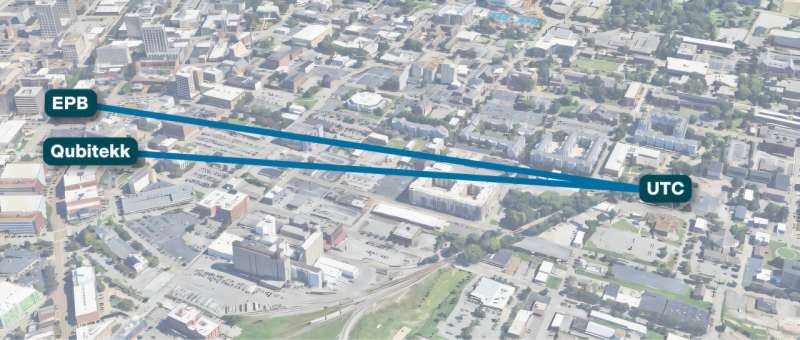Researchers at the Department of Energy’s Oak Ridge National Laboratory joined forces with EPB of Chattanooga and the University of Tennessee at Chattanooga to demonstrate the first transmission of an entangled quantum signal using multiple wavelength channels and automatic polarization stabilization over a commercial network with no downtime.
The successful trial of this innovation marks another step toward the eventual creation of a quantum internet that could prove to be more capable and secure than existing networks.
The demonstration used automatic polarization compensation, or APC, to stabilize the polarization, or direction of the electric field oscillation in a light wave, of a signal sent over the EPB’s fiber-optic commercial quantum network. The approach used reference signals generated by lasers to continuously check the transmitted polarization, detected with an ultrasensitive method known as heterodyne detection.
APCs reduce data interference caused by outside forces like wind and temperature changes that can affect the fiber optic cables used to transmit quantum signals.
“One of our goals all along has been to develop quantum communications systems that operate seamlessly for users,” said Joseph Chapman, an ORNL quantum research scientist who led the study now published in Optics Express.
“This is the first demonstration of this method, which enabled relatively fast stabilization while preserving the quantum signals, all with 100% uptime—meaning the people at either end of this transmission won’t notice any interruption in the signal and don’t need to coordinate scheduled downtime.”
The method enabled continuous transmission of the signals with no interruptions for more than 30 hours between the node on the University of Tennessee Chattanooga campus and two other EPB quantum network nodes, each about half a mile away. The UTC node held an entangled-photon source developed by Muneer Alshowkan, an ORNL quantum research scientist.
Quantum computing relies on quantum bits, or qubits, to store information. Qubits, unlike the binary bits used in classical computing, can exist in more than one state simultaneously via quantum superposition, which allows combinations of physical values to be encoded on a single object.
The ORNL study used light particles, or photons, as qubits and transmitted the polarization-entangled qubits on photon pairs via quantum entanglement distribution. Entangled qubits are so intertwined that one can’t be described independently of the other. That entanglement allows the information encoded in qubits to be transmitted from one place to another via quantum teleportation without physical travel through space. Entanglement distribution and quantum teleportation form the bedrock of more advanced quantum networks.

Photons can be encoded as qubits via polarization, along with other properties of light, and can be transmitted over existing fiber-optic cable systems. But wind, moisture, changes in temperature and other stresses on the cable can disrupt the photons’ polarization and interfere with the signal. Chapman and the ORNL team wanted to find a way to stabilize the polarization and reduce interference while keeping the network running at maximum bandwidth.
“Most previous solutions didn’t necessarily work for all types of polarizations and required trade-offs like periodically resetting the network,” Chapman said. “People using the network need it up and running. Our approach controls for any type of polarization and doesn’t require the network to periodically shut down.”
Chapman and Alshowkan tested the compensation method by generating test signals from entangled photons using entanglement-assisted quantum process tomography, which estimates the properties of a quantum channel—such as the in-ground fiber with APC—to measure for changes. The transmissions remained relatively stable with minimal added noise when APC was enabled.
“An experienced musician with a good ear can tell the difference when two instruments are out of tune,” Chapman said. “In our APC, we’re using a laser to do the same thing with our reference signals.”
Chapman has applied for a patent on the method. Next steps include adjusting the approach to increase bandwidth and compensation range to enable high-performance operation under a wider variety of conditions.
“Working with organizations like ORNL provides valuable feedback for how we can continue to enhance EPB Quantum Network as a resource for researchers, startups and academic customers,” said David Wade, EPB’s CEO. “Since launching a commercially viable quantum network, we’ve begun working to prepare our community to benefit from the advancements in the quantum future and establish Chattanooga as a destination for developers and investment.”
UTC officials pledged to continue their support.
“We’re excited about being part of this successful teamwork,” said Reinhold Mann, vice chancellor for research at UTC. “This partnership advances quantum information science and technology and adds to our special experiential learning offering for our students.”
More information:
Joseph C. Chapman et al, Continuous automatic polarization channel stabilization from heterodyne detection of coexisting dim reference signals, Optics Express (2024). DOI: 10.1364/OE.543704
Citation:
Collaboration tests new method for protecting quantum networks (2025, January 13)
retrieved 13 January 2025
from
This document is subject to copyright. Apart from any fair dealing for the purpose of private study or research, no
part may be reproduced without the written permission. The content is provided for information purposes only.

